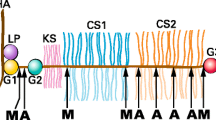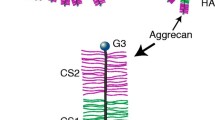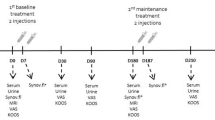Abstract
Purpose
We analysed hyaline cartilage of human knee and ankle joints for collagen and proteoglycan turnover in order to find differences in the metabolism and biochemical content of the extracellular matrix that could explain the higher prevalence of osteoarthritis (OA) in the knee joint, compared to the ankle joint.
Methods
Cartilage tissue from ankle and knee joints of OA patients were assessed for total collagen and proteoglycan content. For turnover, the aggrecan 846-epitope (CS 846), the type II collagen C-propeptide (CP2) and the collagenase-generated intrahelical cleavage neoepitope (C2C) were quantified.
Results
Molecular analyses showed that type II collagen turnover (CP2 and C2C) was significantly elevated in the ankle, whereas aggrecan turnover (CS 846), total proteoglycan and total collagen were comparable between both joints. Analysis of the inter-relationships in the components of cartilage matrix turnover showed a significant positive correlation of C2C vs CP2.
Conclusions
The data suggest an increased type II collagen turnover in ankle vs knee OA cartilage but a comparable aggrecan turnover and comparable contents of type II collagen and proteoglycan. These findings point towards a focused attempt in advanced OA cartilage to structurally repair the collagen network that was more pronounced in the ankle joint and may explain in part the higher prevalence of OA in the knee as compared to the ankle joint.



Similar content being viewed by others
References
Felson DT, Naimark A, Anderson J, Kazis L, Castelliand W, Meenan RF (1987) The prevalence of knee osteoarthritis in the elderly. The Framingham Osteoarthritis Study. Arthritis Rheum 30(8):914–918
Koepp H, Eger W, Muehleman C, Valdellon A, Buckwalter JA, Kuettner KE, Cole AA (1999) Prevalence of articular cartilage degeneration in the ankle and knee joints of human organ donors. J Orthop Sci 4(6):407–412
Peyron JG (1984) The epidemiology of osteoarthritis. In: Moskowitz RW (ed) Osteoarthritis: diagnosis and treatment. W. B. Saunders, Philadelphia, pp 9–27
Bush JR, Beier F (2013) TGF-beta and osteoarthritis—the good and the bad. Nat Med 19(6):667–669
Williams JM (1992) Animal models of articular cartilage repair. In: Schleyerbach R, Peyron JG, Hascall VC (eds) Articular cartilage and osteoarthritis, KE Kuettner. Raven, New York, pp 511–525
Aigner T, Dudhia J (1997) Phenotypic modulation of chondrocytes as a potential therapeutic target in osteoarthritis: a hypothesis. Ann Rheum Dis 56(5):287–291
Xu L, Servais J, Polur I, Kim D, Lee PL, Chung K, Li Y (2010) Attenuation of osteoarthritis progression by reduction of discoidin domain receptor 2 in mice. Arthritis Rheum 62(9):2736–2744. doi:10.1002/art.27582
Pulsatelli L, Addimanda O, Brusi V, Pavloskaand B, Meliconi R (2013) New findings in osteoarthritis pathogenesis: therapeutic implications. Ther Adv Chronic Dis 4(1):23–43. doi:10.1177/2040622312462734
Gebhard PM, Gehrsitz A, Bau B, Söder S, Eger W, Aigner T (2003) Quantification of expression levels of cellular differentiation markers does not support a general shift in the cellular phenotype of osteoarthritic chondrocytes. J Orthop Res 21(1):96–101
Nelson F, Dahlberg L, Laverty S, Reiner A, Pidoux I, Ionescu M, Fraser GL, Brooks E, Tanzer M, Rosenberg LC, Dieppe P, Poole AR (1998) Evidence for altered synthesis of type II collagen in patients with osteoarthritis. J Clin Invest 102(12):2115–2125
Glant TT, Mikecz K, Roughley PJ, Buzás E, Poole AR (1986) Age-related changes in protein-related epitopes of human articular-cartilage proteoglycans. Biochem J 236(1):71–75
Rizkalla G, Reiner A, Bogoch E, Poole AR (1992) Studies of the articular cartilage proteoglycan aggrecan in health and osteoarthritis. Evidence for molecular heterogeneity and extensive molecular changes in disease. J Clin Invest 90(6):2268–2277
Billinghurst RC, Dahlberg L, Ionescu M, Reiner A, Bourne R, Rorabeck C, Mitchell P, Hambor J, Diekmann O, Tschesche H, Chen J, Van Wart H, Poole AR (1997) Enhanced cleavage of type II collagen by collagenases in osteoarthritic articular cartilage. J Clin Invest 99(7):1534–1545
Aurich M, Poole AR, Reiner A, Mollenhauer C, Margulis A, Kuettner KE, Cole AA (2002) Matrix homeostasis in aging normal human ankle cartilage. Arthritis Rheum 46(11):2903–2910
Aurich M, Mwale F, Reiner A, Mollenhauer JA, Anders JO, Fuhrmann RA, Kuettner KE, Poole AR, Cole AA (2006) Collagen and proteoglycan turnover in focally damaged human ankle cartilage: evidence for a generalized response and active matrix remodeling across the entire joint surface. Arthritis Rheum 54(1):244–252
Aurich M, Squires GR, Reiner A, Mollenhauer JA, Kuettner KE, Poole AR, Cole AA (2005) Differential matrix degradation and turnover in early cartilage lesions of human knee and ankle joints. Arthritis Rheum 52(1):112–119
Aurich M, Eger W, Rolauffs B, Margulis A, Kuettner KE, Mollenhauer JA, Cole AA (2006) Ankle chondrocytes are more resistant to Interleukin-1 than chondrocytes derived from the knee. Orthopade 35(7):784–790
Altman RD (1991) Classification of disease: osteoarthritis. Semin Arthritis Rheum 20(6 Suppl 2):40–47
Chubinskaya S, Kuettner KE, Cole AA (1999) Expression of matrix metalloproteinases in normal and damaged articular cartilage from human knee and ankle joints. Lab Investig 79(12):1669–1677
Mankin HJ, Dorfman H, Lippiello L, Zarins A (1971) Biochemical and metabolic abnormalities in articular cartilage from osteo-arthritic human hips. II Correlation of morphology with biochemical and metabolic data. J Bone Joint Surg Am 53(3):523–537
Farndale RW, Buttle DJ, Barrett AJ (1986) Improved quantitation and discrimination of sulphated glycosaminoglycans by use of dimethylmethylene blue. Biochim Biophys Acta 883(2):173–177
Huszar G, Maiocco J, Naftolin F (1980) Monitoring of collagen and collagen fragments in chromatography of protein mixtures. Anal Biochem 105(2):424–429
Kim YJ, Sah RL, Doong JY, Grodzinsky AJ (1988) Fluorometric assay of DNA in cartilage explants using Hoechst 33258. Anal Biochem 174(1):168–176
Poole AR, Rizkalla G, Ionescu M, Reiner A, Brooks E, Rorabeck C, Bourne R, Bogoch E (1993) Osteoarthritis in the human knee: a dynamic process of cartilage matrix degradation, synthesis and reorganization. Agents Actions Suppl 39:3–13
Acknowledgements
We would like to thank Jana Schömburg und Christine Mollenhauer for their help in sample preparation and Dr. Juergen Mollenhauer for the useful discussions during this project. All experimental data were collected at the Orthopaedic Research Laboratories of the University of Jena. Special thank goes to the Deutsche Forschungsgemeinschaft (DFG), the Deutsche Arthrosehilfe e.V., and the Interdisciplinary Center for Clinical Research (IZKF) of the University of Jena for the financial support of this work.
Author information
Authors and Affiliations
Corresponding author
Ethics declarations
Conflict of interest
The authors declare that they have no conflict of interest.
Funding
This work was supported in part by a grant from the Deutsche Forschungsgemeinschaft DFG 156/6-1), Deutsche Arthrosehilfe e.V. and the Interdisciplinary Center for Clinical Research (IZKF) (M.A.). The funding sources had no involvement in study design, in the collection, analysis and interpretation of data, in the writing of the report or in the decision to submit the article for publication.
Ethical approval
The study has been approved by the local ethics committee (approval #0981-10/02 from the Ethics Committee of the Medical Faculty at the University of Jena, Jena, Germany) and was performed in concordance with the 1964 Declaration of Helsinki and according to the German Data Protection Act. Before the start of the investigation, written informed consent was obtained. The legal requirements concerning confidential medical communication were met. At any time, the patients had the right to withdraw consent without giving reasons and without disadvantages regarding further medical treatment. The medical therapy of the patients during hospitalization was performed independently of this research project. Patient data was stored exclusively in the Hospital according to current data protection laws. Third persons were not provided insight into source data. Any patient has the right to have his data deleted.
Informed consent
Informed consent was obtained from all individual participants included in the study.
Rights and permissions
About this article
Cite this article
Aurich, M., Hofmann, G.O. & Rolauffs, B. Differences in type II collagen turnover of osteoarthritic human knee and ankle joints. International Orthopaedics (SICOT) 41, 999–1005 (2017). https://doi.org/10.1007/s00264-017-3414-5
Received:
Accepted:
Published:
Issue Date:
DOI: https://doi.org/10.1007/s00264-017-3414-5




